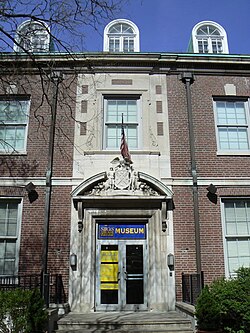Staten Island Museum

Main Entrance
|
|
| Established | 1881 |
|---|---|
| Location | 75 Stuyvesant Place, Staten Island, New York, United States |
| Coordinates | 40°38′39″N 74°04′40″W / 40.64419°N 74.07776°W |
| Type | General Interest Museum |
| Public transit access | Saint George Terminal |
| Website | www.statenislandmuseum.org |
Staten Island Museum (officially the Staten Island Institute of Arts & Sciences) is Staten Island’s oldest cultural institution, and the only remaining general interest museum in New York City.
Founded in 1881 by fourteen of New York City’s first “environmental activists”, the Staten Island Museum houses artifacts and specimens from ancient to contemporary periods. This “mini-Smithsonian” is rich with arts, natural sciences and local history.
The museum’s holdings are formally organized into three main collections: Natural Sciences, Fine Art, and History Archives & Library. The natural science collections encompass over 500,000 botanical, biological, anthropological and mineral specimens including bird nests and eggs, mounted animals, fossils, shells, and a significant collection of insects, including important type of specimens. Based upon a 19th-century model, the art collection includes works spanning prehistory to the modern period, with representations of diverse world cultures from both the Western and Non-Western traditions. The historical collections include a library, maps and atlases, early films, audio recordings, photographs, historical objects, ephemera and archival documents reaching back to the 17th century.
The Staten Island Museum was founded in 1881 as a private society of local naturalists and antiquarians who pooled their personal collections to create the public museum in 1908. William T. Davis, along with Nathaniel Lord Britton, Arthur Hollick,Charles W. Leng, are some of the founding fathers who also contributed significantly to the city’s nature preserve, research and education. The museum focused on environmental protection and has participated in the preservation of High Rock Park and the William T. Davis Wildlife Refuge. Since 1908, the staff has conducted annual bird counts together with the Audubon Society. In 1909, the Section of Art was organized, and in 1919 the Staten Island Institute of Arts & Sciences was incorporated to reflect the broader mission which also includes local history.
The museum has been called a "Mini Smithsonian" because of the breadth of its collections, and is based on a 19th-century model of creating within one's own community the complete resources for a cultural education. As a general interest museum, it is one of the last intact examples of the first type of public museum in America, and today serves a diverse audience of 80,000 people annually, with the goal of providing cross-disciplinary exhibitions for a wide cross-section of visitors.
...
Wikipedia

